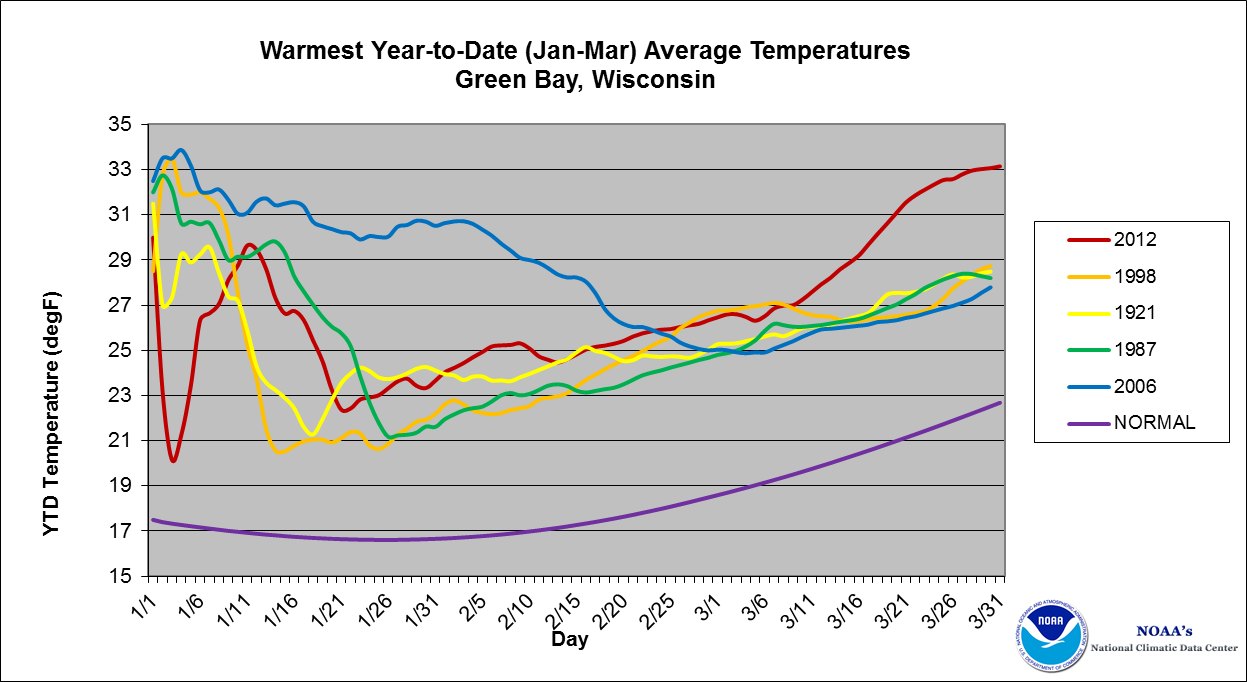Monthly Report Summary Information
The Monthly Report Summary Information is a synopsis of the collection of national and global summaries released each month.
National Summary Information - March 2012
See Full Report
U.S. records warmest March; more than 15,000 warm temperature records broken
First quarter of 2012 also warmest on record; early March tornado outbreak is year's first "billion dollar disaster"
Record and near-record breaking temperatures dominated the eastern two-thirds of the nation and contributed to the warmest March on record for the contiguous United States, a record that dates back to 1895. More than 15,000 warm temperature records were broken during the month.
The average temperature of 51.1°F was 8.6 degrees above the 20th century average for March and 0.5°F warmer than the previous warmest March in 1910. Of the more than 1,400 months (117+ years) that have passed since the U.S. climate record began, only one month, January 2006, has seen a larger departure from its average temperature than March 2012.
Note: The March 2012 Monthly Climate Report for the United States has several pages of supplemental information and data regarding the unprecedented early 2012 temperatures.
U.S. climate highlights — March
- Every state in the nation experienced at least one record warm daily temperature during March. According to preliminary data, there were 15,272 warm temperature records broken (7,755 daytime records, 7,517 nighttime records). Hundreds of locations across the country broke their all-time March records. There were 21 instances of the nighttime temperatures being as warm, or warmer, than the existing record daytime temperature for a given date.
- A persistent weather pattern led to 25 states east of the Rockies having their warmest March on record. An additional 15 states had monthly temperatures ranking among their ten warmest. That same pattern brought cooler-than-average conditions to the West Coast states of Washington, Oregon, and California.
- Temperatures in Alaska during March, which are not included in the contiguous U.S. average value, ranked as the tenth coolest on record.
- The nationally-averaged precipitation total was 2.73 inches, which is 0.33 inches above average. The Pacific Northwest and the Southern Plains were much wetter than average during March while drier-than-average conditions prevailed in the interior West, Northeast, and Florida. Colorado had its driest March on record.
- According to the U.S. Drought Monitor, as of April 3rd, 36.8 percent of the contiguous U.S. was in drought, a decrease from 38.7 percent at the end of February and an increase from 28.8 percent a year ago on April 5, 2011. Above-average precipitation across the Southern Plains improved long-term drought conditions Texas, Oklahoma, and Kansas.
- Warmer-than-average conditions across the eastern U.S. also created an environment favorable for severe thunderstorms and tornadoes. According to NOAA's Storm Prediction Center, there were 223 preliminary tornado reports during March, a month that averages 80 tornadoes annually. The majority of the tornadoes occurred during the March 2nd-3rd outbreak across the Ohio Valley and Southeast, which caused 40 fatalities. Total losses from this event are estimated to exceed $1.5 billion dollars, making this the first event of 2012 to exceed one billion dollars in damages and losses.
- On March 9, a large weather system impacted the Hawaiian Islands, bringing extreme rainfall and severe thunderstorms. A rare EF-0 tornado hit the towns of Lanikai and Kailua on Oahu, causing minor damage. A hailstone with the largest diameter on record for the state, measuring 4¼ inches, fell on Oahu during this event.
Year-to-date (January-March)
- The first three months of 2012 were also record warm for the contiguous United States with an average temperature of 42.0°F, 6.0°F above the long-term average.
- Twenty-five states, all east of the Rockies, had their warmest first quarter on record, and an additional 16 states had first-quarter temperatures ranking among their ten warmest.
- Numerous cities had a record warm January-March, including Chicago, Boston, and Washington, D.C. No state in the contiguous U.S. had below-average January-March temperatures.
- Alaska had its ninth coolest January-March period; temperatures were 5.2°F below average.
- The nationally-averaged precipitation total for January-March was 0.29 inches below the long-term average. States across the Pacific Northwest and Southern Plains were wetter than average, while the Intermountain West, parts of the Ohio Valley, and the entire Eastern Seaboard were drier than average.
- NOAA's U.S. Climate Extremes Index, an index that tracks the highest 10 percent and lowest 10 percent of extremes in temperature, precipitation, drought and tropical cyclones, was 39 percent, nearly twice the long-term average and the highest value on record for the January-March period. The predominant factor was the large area experiencing extremes in warm daily maximum and minimum temperatures.
Cold season (October-March) and 12-month period (April 2011-May 2012)
- The cold season, which is defined as October 2011 through March 2012 and an important period for national heating needs, was second warmest on record for the contiguous U.S. with a nationally-averaged temperature 3.8°F above average. Only the cold season of 1999-2000 was warmer. Twenty-one states across the Midwest and Northeast, areas of the country with high annual heating demands, were record warm for the six-month period.
- The previous 12-month period (April-March), which includes the second hottest summer (June-August) and fourth warmest winter (December-February), was the warmest such period for the contiguous United States. The 12-month running average temperature was 55.4°F, which is 2.6°F above the 20th century average.
 NOAA's National Centers for Environmental Information
NOAA's National Centers for Environmental Information


 Year-to-Date temperature evolution for Green Bay, Wisconsin versus the previous four warmest years.
Year-to-Date temperature evolution for Green Bay, Wisconsin versus the previous four warmest years. Heating Degree Day amomalies, October 2011 through March 2012, versus the 1981-2010 average.
Heating Degree Day amomalies, October 2011 through March 2012, versus the 1981-2010 average.